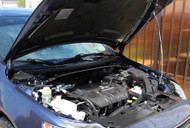The Beginner's Guide to Engine Mounts
6th Mar 2019

Engine Motor Mounts
Also known as motor mounts, engine mounts play an important role in the function of modern-day automotive engines. Regardless of what type of vehicle you drive, it probably has motor mounts. The purpose of these small metal and rubber pieces is to absorb vibrations created by the engine, thereby allowing for a smoother and more enjoyable driving experience.
Where Are Engine Mounts Located?
You can usually find engine mounts located around the bottom sides of your vehicle's engine. Some vehicles only have two engine mounts -- one on each side -- though others have three or four. Regardless, you can usually find them by inspecting the bottom sides of your car's engines. Assuming they are traditional elastomeric engine mounts, they'll look like small metal and rubber pieces connecting your car's engine to the chassis.
Do Engine Mounts Go Bad?
Engine mounts, like most automotive components, can fail. This usually occurs either in high-mileage vehicles or from overly aggressive or careless driving. Over time, the rubber particles from which the engine mounts are made begin to break down, resulting in gradual degradation of the engine mount.
Eventually, the worn engine mounts will no longer be able to effectively absorb vibrations. As the engine vibrations, the vibrations travel through the car's chassis and into the cabin where they are felt by the driver and his or her passengers. Aside from a bumpy ride, however, driving with worn engine mounts for a prolonged period could damage your car's drive shaft.
Are There Different Types of Engine Mounts?
Yes, there are three primary types of engine mounts. While all three types are designed to absorb vibrations produced by the engine, the way in which they work varies. See below for a breakdown of the three types of engine mounts:
- Elastomeric: The most common type, elastomeric engine mounts are made primarily of rubber and metal.
- Hydraulic: Hydraulic engine mounts contain hydraulic fluid to further absorb and isolate vibrations produced by the engine.
- Active: Finally, active engine mounts use an a countering component to cancel the vibrations produced by the engine.
What About Transmission Mounts?
In addition to engine mounts, most vehicles are equipped with transmission mounts, which as the name suggests are attached to the transmission. Transmission mounts serve a similar purpose as engine mounts by absorbing vibrations. The difference, however, is that transmission mounts are attached to the transmission, whereas engine mounts are attached to the engine.


